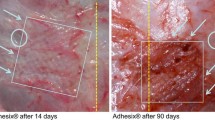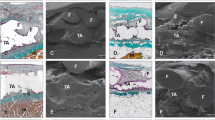Abstract
Purpose
The use of cyanoacrylate (CA)-based tissue adhesives for mesh fixation in abdominal hernia repair is increasing due to the fast action and bond strength of these glues. The aim of the present study was to assess tissue changes induced by different CA glues used for mesh fixation in an animal model.
Methods
Parietal defects were induced in the abdominal wall of 60 rats and repaired by polyvinylidene fluoride (PVDF) mesh fixation using different CA glues. At 1, 7, 15, and 30 days post-surgery, macroscopic and histopathological studies were performed to evaluate mesh adhesion, the presence of complications and the tissue response.
Results
All meshes were successfully fixed without signs of inflammatory reaction, displacement or detachment. In areas where CA adhesives were applied, the acute tissue response was limited and transient. At 7 days post-surgery, collagen fibril production around prosthetic materials was observed, and collagen maturation was achieved at 30 days post-surgery. Good mesh incorporation was detected with all three glues, but the application of Glubran-2 was associated with an early macrophagic response and the early production and maturation of collagen fibrils.
Conclusions
Our study confirmed that CA tissue adhesives induced the good incorporation of prosthetic mesh within host tissue with a low incidence of complications and reduced acute tissue reaction. At 30 days post-surgery no signs of mesh disinsertion or migration were observed, the prosthetic mesh adhesion was due to the presence of a dense mature connective tissue rich in type I collagen fibres.







Similar content being viewed by others
Change history
05 February 2020
Unfortunately, during the revision of the manuscript the title has been incorrectly published
References
Luijendijk RW, Hop WC, van den Tol MP, de Lange DC, Braaksma MM, Ijzermans JN, Boelhouwer RU, de Vries BC, Salu MK, Wereldsma JC, Bruijninckx CM, Jeekel J (2000) A comparison of suture repair with mesh repair for incisional hernia. N Engl J Med 343:392–398. https://doi.org/10.1056/nejm200008103430603
Kim-Fuchs C, Angst E, Vorburger S, Helbling C, Candinas D, Schlumpf R (2012) Prospective randomized trial comparing sutured with sutureless mesh fixation for Lichtenstein hernia repair: long-term results. Hernia 16:21–27. https://doi.org/10.1007/s10029-011-0856-3
Cuschieri A (2001) Tissue adhesives in endosurgery. Semin Laparosc Surg 8:63–68. https://doi.org/10.1053/slas.2001.24087
Ladurner R, Drosse I, Bürklein D, Plitz W, Barbaryka G, Kirchhoff C, Kirchhoff S, Mutschler W, Schieker M, Mussack T (2011) Cyanoacrylate glue for intra-abdominal mesh fixation of polypropylene-polyvinylidene fluoride meshes in a rabbit model. J Surg Res 167(2):e157–e162. https://doi.org/10.1016/j.jss.2009.11.710
Bellón JM, Fernández-Gutiérrez M, Rodríguez M, Sotomayor S, Pérez-Köhler B, Kuhnhardt A, Pascual G, San Román J (2017) Bioassay of cyanoacrylate tissue adhesives used for intraperitoneal mesh fixation. J Biomed Mater Res B Appl Biomater 105(2):312–319. https://doi.org/10.1002/jbm.b.33558
Gruber-Blum S, Petter-Puchner AH, Brand J, Fortelny RH, Walder N, Oehlinger W, Koenig F, Redl H (2011) Comparison of three separate antiadhesive barriers for intraperitoneal onlay mesh hernia repair in an experimental model. Br J Surg 98:442–449. https://doi.org/10.1002/bjs.7334
Hollinsky C, Kolbe T, Walter I, Joachim A, Sandberg S, Koch T, Rulicke T, Tuchmann A (2010) Tensile strength and adhesion formation of mesh fixation systems used in laparoscopic incisional hernia repair. Surg Endosc 24:1318–1324. https://doi.org/10.1007/s00464-009-0767-x
Bellon JM, Fernandez-Gutierrez M, Rodriguez M, Perez-Lopez P, Perez-Kohler B, Kuhnhardt A, Pascual G, Roman JS (2017) Behavior of a new long-chain cyanoacrylate tissue adhesive used for mesh fixation in hernia repair. J Surg Res 208:68–83. https://doi.org/10.1016/j.jss.2016.09.021
Koehler RH, Begos D, Berger D, Carey S, LeBlanc K, Park A, Ramshaw B, Smoot R, Voeller G (2003) Minimal adhesions to ePTFE mesh after laparoscopic ventral incisional hernia repair: reoperative findings in 65 cases. JSLS 7:335–340. https://doi.org/10.1055/s-2003-41365
Suarez-Grau JM, Morales-Conde S, Martin-Cartes JA, Chaves CR, Jimenez MB, Ramirez FP, Docobo-Durantez F, Mendez SM (2009) Mesh fixation with sutures versus fibrin sealant in hernioplasty with re-absorbable prosthesis (polyglycolic acid and trimethylene carbonate). Experimental study in animals. Cir Esp 86:242–248. https://doi.org/10.1016/j.ciresp.2009.05.004
Colvin HS, Rao A, Cavali M, Campanelli G, Amin AI (2013) Glue versus suture fixation of mesh during open repair of inguinal hernias: a systematic review and meta-analysis. World J Surg 37:2282–2292. https://doi.org/10.1007/s00268-013-2140-4
Gupta A, Mazari F, Samuel N, Balehandra S (2017) Mesh fixation techniques for laparoscopic inguinal hernia repair in adults. Cochrane Database Syst Rev 2017:CD008954. https://doi.org/10.1002/14651858.cd008954.pub2
Kongyuan W, Cuncun L, Long G, Bei P, Huan Y, Jinhui T, Nong C (2018) Different types of mesh fixation for laparoscopic repair of inguinal hernia: a protocol for systematic review and network meta-analysis with randomized controlled trials. Medicine (Baltimore) 97:e0423. https://doi.org/10.1097/md.0000000000010423
Losi P, Burchielli S, Spiller D, Finotti V, Kull S, Briganti E, Soldani G (2010) Cyanoacrylate surgical glue as an alternative to suture threads for mesh fixation in hernia repair. J Surg Res 163:e53–e58. https://doi.org/10.1016/j.jss.2010.05.003
Jin J, Schomisch S, Rosen MJ (2009) In vitro evaluation of the permeability of prosthetic meshes as the possible cause of postoperative seroma formation. Surg Innov 16:129–133. https://doi.org/10.1177/1553350609337128
Pascual G, Rodriguez M, Perez-Kohler B, Mesa-Ciller C, Fernandez-Gutierrez M, Roman JS, Bellon JM (2017) Host tissue response by the expression of collagen to cyanoacrylate adhesives used in implant fixation for abdominal hernia repair. J Mater Sci Mater Med 28:58. https://doi.org/10.1007/s10856-017-5869-8
Ladurner R, Drosse I, Seitz S, Plitz W, Barbaryka G, Siebeck M, Burklein D, Kirchhoff C, Buhman S, Mutschler W, Schieker M, Mussack T (2008) Tissue attachment strength and adhesion formation of intraabdominal fixed meshes with cyanoacrylat glues. Eur J Med Res 13:185–191
Clarke T, Katkhouda N, Mason RJ, Cheng BC, Algra J, Olasky J, Sohn HJ, Moazzez A, Balouch M (2011) Fibrin glue for intraperitoneal laparoscopic mesh fixation: a comparative study in a swine model. Surg Endosc 25:737–748. https://doi.org/10.1007/s00464-010-1244-2
Fortelny RH, Petter-Puchner AH, Walder N, Mittermayr R, Ohlinger W, Heinze A, Redl H (2007) Cyanoacrylate tissue sealant impairs tissue integration of macroporous mesh in experimental hernia repair. Surg Endosc 21:1781–1785. https://doi.org/10.1007/s00464-007-9243-7
Fernandez-Gutierrez M, Rodriguez-Mancheno M, Perez-Kohler B, Pascual G, Bellon JM, Roman JS (2016) Structural analysis and application of n-alkyl cyanoacrylate surgical adhesives to the fixation of meshes for hernia repair. Macromol Biosci 16:1803–1814. https://doi.org/10.1002/mabi.201600246
Testini M, Lissidini G, Poli E, Gurrado A, Lardo D, Piccinni G (2010) A single-surgeon randomized trial comparing sutures, N-butyl-2-cyanoacrylate and human fibrin glue for mesh fixation during primary inguinal hernia repair. Can J Surg 53:155–160
Kukleta JF, Freytag C, Weber M (2012) Efficiency and safety of mesh fixation in laparoscopic inguinal hernia repair using n-butyl cyanoacrylate: long-term biocompatibility in over 1,300 mesh fixations. Hernia 16:153–162. https://doi.org/10.1007/s10029-011-0887-9
Garcia-Vallejo L, Couto-Gonzalez I, Concheiro-Coello P, Brea-Garcia B, Taboada-Suarez A (2014) Cyanoacrylate surgical glue for mesh fixation in laparoscopic total extraperitoneal hernia repair. Surg Laparosc Endosc Percutan Tech 24:240–243. https://doi.org/10.1097/SLE.0b013e3182a2f008
Liu X, Wu H, Byrne M, Krane S, Jaenisch R (1997) Type III collagen is crucial for collagen I fibrillogenesis and for normal cardiovascular development. Proc Natl Acad Sci USA 94:1852–1856. https://doi.org/10.1073/pnas.94.5.1852
Cerda DG, Ballester AM, Aliena-Valero A, Caraben-Redano A, Lloris JM (2015) Use of cyanoacrylate adhesives in general surgery. Surg Today 45:939–956. https://doi.org/10.1007/s00595-014-1056-4
Wynn TA, Barron L (2010) Macrophages: master regulators of inflammation and fibrosis. Semin Liver Dis 30:245–257. https://doi.org/10.1055/s-0030-1255354
Funding
Restricted grant provided by GEM Srl for data analysis.
Author information
Authors and Affiliations
Corresponding author
Ethics declarations
Conflict of interest
The authors declare no conflicts of interest.
Human and animal rights
All procedures performed in studies involving animals were in accordance with the international ethical standards. This article does not contain any studies with human participants performed by any of the authors.
Ethical approval
Permission to conduct this experimental study (Authorization n. 755/2015-PR) was granted by the Italian Ministry of Health, in accordance with Italian Laws DL.gs 26/2014 and Directive 2010/63/EU on the protection of animals used for scientific purposes.
Informed consent
No informed consent was necessary for the study.
Additional information
Publisher's Note
Springer Nature remains neutral with regard to jurisdictional claims in published maps and institutional affiliations.
The original version of this article was revised: Due to Title update.
Rights and permissions
About this article
Cite this article
Poli, A., Parisi, F., Millanta, F. et al. Fixation of polyvinylidene fluoride (PVDF) mesh with cyanoacrylate-derived glues in a rat experimental model: histopathologic immunohistochemical and morphometric study. Hernia 24, 1263–1273 (2020). https://doi.org/10.1007/s10029-019-02078-5
Received:
Accepted:
Published:
Issue Date:
DOI: https://doi.org/10.1007/s10029-019-02078-5




